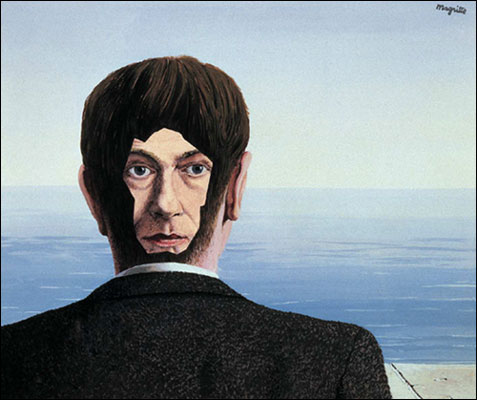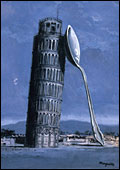The number of retrospectives dedicated to Magritte’s work has multiplied over the last fifteen years, and it is now internationally recognized as one of the essential moments of XXth century art. This exhibition is different. On the one hand it offers an aspect of his work that is hardly known –letters, sketches, etchings on paper, preparatory drawings, gouache studies, squared preparations, gouaches taken from paintings, collages... On the other hand, the exhibition represents an original insight into the makig of a subversive mind. This is a true retrospective of his work with its traditional images and its unknown aspects.
Drawings, a story in action
Magritte considers the collage as an essential component of modernist culture. It introduces a break in theprinciple itself of representation. But, while it represents a fundamental aspect in Magrittte’s procedure, it has also changed its language radically. Here we reach a major point in Surrealist poetry. From the beginning, drawing has been an important element in the research Magritte carried out and covers all of his work. From the etchings to the sketches introduced in the letters, he built the image while testing the idea according to which all drawings are a story in action. By showing how Magritte used the supports and techniques we find his creative process. From the lettter to the image, the laboratory of the work functions according to the example of a mind in perpetual movement.
The Magritte Variations
The mediocre result reached with the little paintings for the Julian Levy Gallery in 1938 led Magritte to assimilate gouache and variant, according to a commercial process Iolas exploited as of 1948. This technique always had a promotional value for him. We see this starting with the advertising work he did in the 20s. It is presented here and introduces the copies that were done in gouache for commercial reasons. Through this means Magritte shatters the unique value of the work without for that losing the aura. The gouache allows the painting not to be seen as a conventional practice. It becomes a «poetic idea» condemned to be repeated, taken up again, transformed by the gouache. Here we enter the game of variant which Magritte never ceased to play with freedom and irony.
Colour as light
Directly derived from advertisements, the gouache relies on an affirmation of colour as light. Magritte experimented it in opposition to his own oil painting with somber and tragic tones. The gouache is hand in hand with the sun, and gladly expresses itself under a hedonist and sensual form. But its liveliness has also nurtured the viciousness of his « mean period ». The confrontation between the series tells of different horizons. From one to the other, two chromatic values of the gouache –the post-Impressionist from Renoir or the Expressionist and Fauvist –influence Magritte when he aims at redefining the Surrealist imagination
A means of expression in itself
All this being said, not all gouaches are only variants. Magritte developped in this technique works that are not equaled in painting. The gouache then appears as a means of expression in itself at the same level as certain drawings by pen. The exhibition ends with some of these images, among Magritte’s most captivating ones.
When presented these themes offer another aspect of Magritte’s procedure. The laboratory of the imagination is matched by aspects of hs work that are little known : the importance of the collage, the relationship to colour, the impact of this advertising in which Magritte saw « stupid works »...
Illustration: MAGRITTE La Nuit de Pise, Gouache on cartdboard, 18.7 x 13.6 cm. Switzerland Private collection Photo Roy Fox.
PUBLICATION
Catalogue of the exhibition Texts by Michel Draguet 240 p. 250 Ill. 24x 28 cm. Hazan Publishers. Paperback 35 €
To see more illustrations, click on VERSION FRANCAISE at the top of this page
| 








